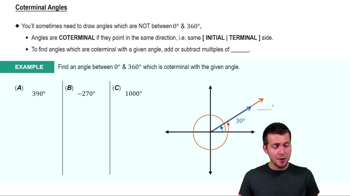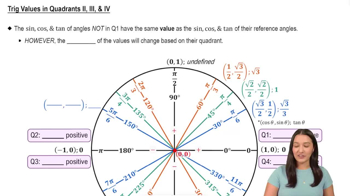Table of contents
- 0. Review of College Algebra4h 43m
- 1. Measuring Angles39m
- 2. Trigonometric Functions on Right Triangles2h 5m
- 3. Unit Circle1h 19m
- 4. Graphing Trigonometric Functions1h 19m
- 5. Inverse Trigonometric Functions and Basic Trigonometric Equations1h 41m
- 6. Trigonometric Identities and More Equations2h 34m
- 7. Non-Right Triangles1h 38m
- 8. Vectors2h 25m
- 9. Polar Equations2h 5m
- 10. Parametric Equations1h 6m
- 11. Graphing Complex Numbers1h 7m
3. Unit Circle
Reference Angles
Problem 46
Textbook Question
In Exercises 44–48, find the reference angle for each angle. -410°
 Verified step by step guidance
Verified step by step guidance1
<Convert the given angle to a positive angle by adding 360° until the angle is positive.>
<Once you have a positive angle, determine if it is greater than 360°. If so, subtract 360° to find the equivalent angle within one full rotation.>
<Identify the quadrant in which the angle lies.>
<Use the quadrant information to find the reference angle. For angles in the third quadrant, subtract 180° from the angle.>
<Express the reference angle as a positive acute angle, which is always between 0° and 90°.>
Recommended similar problem, with video answer:
 Verified Solution
Verified SolutionThis video solution was recommended by our tutors as helpful for the problem above
Video duration:
2mPlay a video:
Was this helpful?
Key Concepts
Here are the essential concepts you must grasp in order to answer the question correctly.
Reference Angle
The reference angle is the acute angle formed by the terminal side of a given angle and the x-axis. It is always measured as a positive angle and is typically between 0° and 90°. For angles greater than 360° or less than 0°, the reference angle can be found by first determining the equivalent angle within the standard range of 0° to 360°.
Recommended video:

Reference Angles on the Unit Circle
Angle Coterminality
Coterminal angles are angles that share the same terminal side when drawn in standard position. To find a coterminal angle, you can add or subtract multiples of 360° from the original angle. For example, to find a coterminal angle for -410°, you would add 360° until the angle falls within the range of 0° to 360°.
Recommended video:

Coterminal Angles
Quadrants of the Coordinate Plane
The coordinate plane is divided into four quadrants, each representing a different range of angles. The first quadrant contains angles from 0° to 90°, the second from 90° to 180°, the third from 180° to 270°, and the fourth from 270° to 360°. Understanding which quadrant an angle lies in helps in determining the reference angle and its corresponding sine, cosine, and tangent values.
Recommended video:

Quadratic Formula

 5:31m
5:31mWatch next
Master Reference Angles on the Unit Circle with a bite sized video explanation from Callie Rethman
Start learningRelated Videos
Related Practice






















